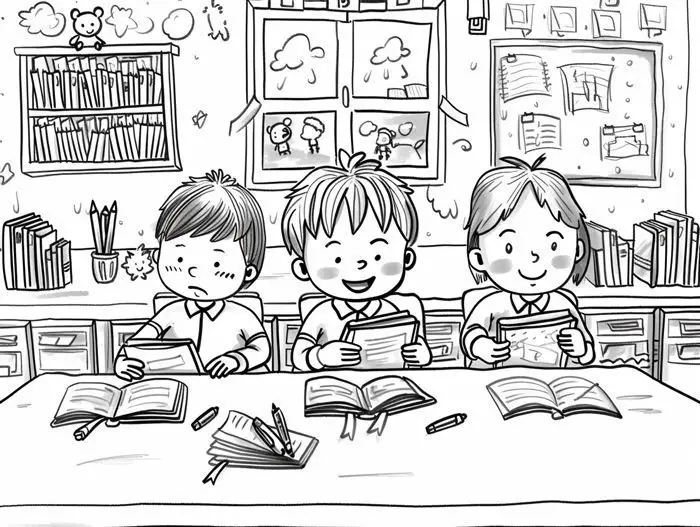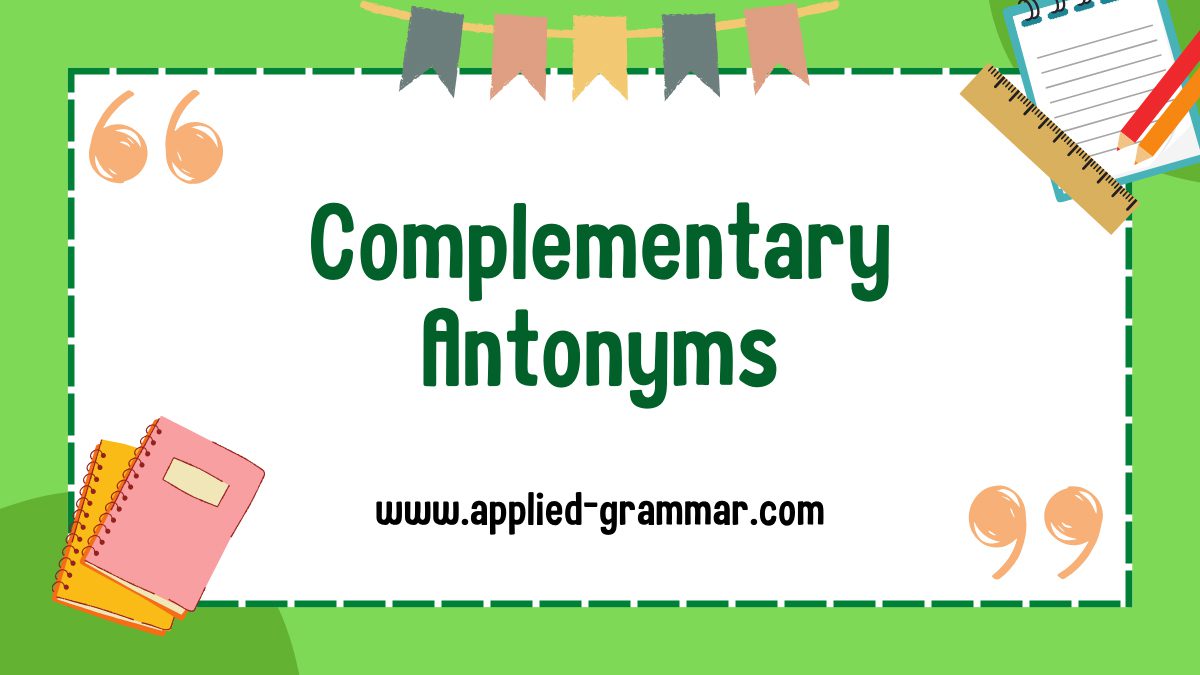Are you familiar with the concept of antonyms? You know, words that have opposite meanings like hot and cold, or big and small. Well, within the area of antonyms, there is a particular type called complementary antonyms. These antonyms go beyond just having opposite definitions – they operate on a unique either-or relationship.
Complementary antonyms are word pairs that have a mutually exclusive nature. In other words, they cannot exist together in the same context. For example, when it comes to the words “on” and “off,” something cannot be a little bit on. It is either on or off. This concept applies to various contexts, from turning on a dishwasher to the role of parents in a family. Complementary antonyms add clarity and precision to our language, allowing us to express ideas in a more concise and effective manner.
Understanding complementary antonyms is not only beneficial for expanding your vocabulary, but it also helps you write more compelling and understandable comparisons. By grasping the concept of these unique word pairs, you can enhance your writing skills and communicate ideas with greater precision. So, let’s investigate into the intriguing area of complementary antonyms and explore how they shape our language and expression.
Key Takeaways
- Complementary antonyms are word pairs that have opposite meanings and operate on an either-or relationship.
- They cannot coexist in the same context and represent clear and distinct choices without any middle ground.
- Complementary antonyms enhance vocabulary and allow for more compelling and understandable comparisons.
- They play a crucial role in design and visual arts, creating visually striking compositions with contrasts.
- Complementary antonyms are also important in language and communication, conveying precise meanings and enhancing the effectiveness of communication.
- By understanding and incorporating complementary antonyms, you can elevate your writing, communication, and design skills.
What are Complementary Antonyms?
Complementary antonyms are a fascinating aspect of language that adds depth and precision to our vocabulary. In this section, we’ll explore the definition of complementary antonyms and provide examples to illustrate their unique characteristics.

Definition of Complementary Antonyms
Complementary antonyms are pairs of words that have opposite meanings and operate on an either-or relationship. Unlike other types of antonyms, complementary antonyms cannot coexist in the same context. One word in the pair excludes the other, and there are no intermediate or partial states between them.
Here are a few key characteristics of complementary antonyms:
- Opposite Meanings: Each word in a complementary antonym pair represents a complete opposite. For example, push and pull, right and wrong, or yes and no.
- Independent Existence: Complementary antonyms can exist independently of each other. In some cases, one word may be present while the complementary opposite is absent. For instance, there may be a daughter without a son.
- Mutually Exclusive: Complementary antonyms cannot be combined or mixed in any way. They represent clear and distinct choices without any middle ground.
Examples of Complementary Antonyms
To further illustrate the concept of complementary antonyms, let’s explore a few examples:
- Alive and dead: These two words represent the absolute opposite states of living beings. Something is either alive or dead, without any middle ground.
- Exit and entrance: An exit is a means of leaving a place, while an entrance is a means of entering. They are mutually exclusive and cannot occur simultaneously.
- Exterior and interior: The exterior refers to the outside of something, while the interior refers to the inside. They are distinct and cannot coexist in the same space.
By understanding complementary antonyms, you can enhance your vocabulary and writing skills. They allow for more compelling and understandable comparisons, adding clarity and precision to your language. Discover the area of complementary antonyms and see how it shapes our expression!
Keep reading to learn more about the various types of antonyms and how they can enrich your language skills.
Characteristics of Complementary Antonyms

Relationship between Complementary Antonyms
Complementary antonyms exhibit a unique relationship where there is no middle ground. Each word pair represents two distinct choices with opposite meanings. For example, when faced with a binary question such as “true or false,” there are no in-between options. This either-or relationship is a defining characteristic of complementary antonyms.
Semantic Contrast in Complementary Antonyms
Complementary antonyms are characterized by their clear and distinct semantic contrast. Each word in the pair is the absolute opposite of the other, without any overlapping or shared meaning. This sharp contrast enhances the expressive power of language by providing contrasting options for comparison and description.
Consider the complementary antonyms “dead” and “alive.” These two words represent opposite states of being, with no possible middle ground between them. The stark contrast between the concept of death and life allows for impactful and nuanced communication.
Another example of complementary antonyms is “exteror” and “interior.” These words represent the opposite spatial orientations or positions of an object or space, further illustrating the clear and distinct nature of complementary antonyms.
Understanding the characteristics of complementary antonyms allows us to leverage their power in enhancing vocabulary and writing skills. By utilizing these clear and contrasting word pairs, we can create more compelling and understandable comparisons, descriptions, and narratives.
Summarizing, complementary antonyms are characterized by their either-or relationship and clear semantic contrast. They offer distinct choices with opposite meanings, allowing for more impactful and precise language use. By incorporating complementary antonyms into your writing, you can elevate your vocabulary and convey your ideas with greater clarity and effectiveness.
Types of Complementary Antonyms
In understanding the concept of complementary antonyms, it’s important to explore the different types they can take. Complementary antonyms are word pairs that represent clear and distinct choices without any middle ground. Let’s investigate into two common types of complementary antonyms: pairs of colors and pairs of directions.

Complementary Pairs of Colors
Complementary pairs of colors are frequently used in art, design, and aesthetics. When it comes to colors, complementary antonyms refer to hues that are opposite to each other on the color wheel. These pairs create a vibrant contrast and are often pleasing to the eye. Some famous examples of complementary color pairs include:
- Blue and orange
- Red and green
- Yellow and purple
Using complementary color combinations can add visual interest and impact to artwork, branding, and interior design. The stark contrast between the colors creates a dynamic and harmonious effect.
Complementary Pairs of Directions
Complementary pairs of directions refer to opposite points on a spectrum or continuum. They represent distinct choices or positions and have a clear opposition between them. Some examples of complementary pairs of directions include:
- North and south
- East and west
- Up and down
These pairs of directions highlight the stark contrast between opposite points and are commonly used to describe locations, travel, and spatial relationships. When giving directions or discussing orientation, understanding these complementary pairs can help provide clear and accurate information.
By recognizing and understanding the different types of complementary antonyms, you can harness the power of language to convey ideas with greater precision. Incorporating these pairs into your writing and communication can enhance your vocabulary and make your statements more impactful and memorable.
Remember, complementary antonyms help us express clear and distinct choices without any middle ground. So, whether you’re discussing colors or directions, understanding these pairs can elevate your language use and ensure effective communication.
Importance and Applications of Complementary Antonyms

Use in Design and Visual Arts
Complementary antonyms play a crucial role in the fields of design and visual arts. By understanding and utilizing these word pairs, designers and artists can create visually striking compositions. Complementary colors, for example, are pairs of hues that are directly opposite each other on the color wheel. When used together, complementary colors create a strong contrast and can evoke specific emotions or moods in a visual piece. This technique is widely used in graphic design, interior design, and various forms of visual art.
Plus to colors, complementary antonyms can also be applied to other design elements, such as shapes, textures, and patterns. By juxtaposing elements with opposite qualities, designers can create dynamic and visually appealing compositions. For instance, combining smooth and rough textures or geometric and organic shapes can add depth and interest to a design. The use of complementary antonyms allows designers to leverage the power of contrasts and create visually engaging experiences.
Use in Language and Communication
Complementary antonyms also have significant applications in language and communication. These word pairs help convey precise meanings, evoke specific emotions, and enhance the effectiveness of communication. By choosing the right complementary antonyms, you can express ideas with clarity and impact.
One way complementary antonyms are used in language is to describe contrasting concepts. Take the word “beginning” and its complementary antonym “end,” for example. Using these words in context allows us to effectively convey the concept of a complete cycle or a journey from start to finish. Similarly, the antonyms “yes” and “no” serve as clear and concise ways to express opposite answers or opinions.
Complementary antonyms can also be used to create persuasive communication. When presenting arguments or making comparisons, using contrasting word pairs can emphasize the strengths or weaknesses of different ideas or options. For instance, the antonyms “efficient” and “inefficient” can be used to highlight the benefits of a particular approach or process.
By understanding and harnessing the power of complementary antonyms, you can elevate your writing and communication skills. These word pairs provide a rich and nuanced way to express ideas and concepts, allowing for clear and impactful communication.
Summarizing, complementary antonyms have important applications in design, visual arts, language, and communication. By leveraging the power of contrasts, these word pairs can create visually striking compositions and enhance the effectiveness of written and spoken communication. Whether you are a designer, artist, writer, or communicator, incorporating complementary antonyms into your work can elevate its impact and ensure effective communication.
Conclusion
By exploring the significance and applications of complementary antonyms in design, visual arts, language, and communication, you now have a deeper understanding of how these concepts can enhance your work. Complementary antonyms, such as complementary colors in design, allow you to create visually captivating compositions that evoke specific emotions. They can also be applied to other design elements, like shapes and textures, to add depth and interest.
In language and communication, complementary antonyms play a crucial role in conveying precise meanings and making your communication more effective. They enable you to describe contrasting concepts, create persuasive communication, and emphasize strengths or weaknesses. By utilizing complementary antonyms, you can elevate your writing and communication skills, ensuring that your message is clear and impactful.
Whether you are a designer, artist, writer, or communicator, understanding and incorporating complementary antonyms into your work will undoubtedly enhance your ability to engage and connect with your audience. So, embrace the power of complementary antonyms and unlock new possibilities in your creative endeavors.
